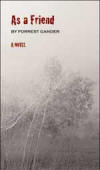As a Friend
Although only 106 pages long, Forrest Gander’s first novel is freighted with the emotional complexity and gritty vividness of a heavy-weight book several times as long.
Although only 106 pages long, Forrest Gander’s first novel is freighted with the emotional complexity and gritty vividness of a heavy-weight book several times as long.
Centered around Les, a charismatic and melancholy twenty-something land surveyor with a penchant for poetry, women, phrases like per usual and verse-visa, the plot deals with the character’s gravitas (“When people saw Les, they touched him . . . He was like a votive stone.”) and its tragic impact on those closest to him.
Set in rural Virginia, the book teems with praying mantises, slugs, lines of black ants, swarms of gnats and various other critters that inhabit the lush southern landscape. With a light touch and philosophical insight, Gander breathes new life into the character-study class of literature without falling flat or overindulging in sentimentality.
The novel is made up of four sections. The first section, “Birth,” details Les’s birth to an unwed girl (“some would say child”) and is given up for adoption: “each waking day, she imagines him, and sometimes in strange dreams. Even after she marries and has other children. She imagines him. Her lost boy. Whatever became of him?”
In the next section, “Clay,” Les is grown. Clay is Les’s co-worker and pal, and tells his story in a relatively traditional narrative style in a series of brief, vivid scenes which explore Clay’s worship and loathing of his friend: “I wanted him to disappear so I could become him.”
The next section, “Sarah,” is told from Les’s girlfriend’s point of view, a girl with whom he is cheating on his second wife. Stylistically, this section is completely different: events are not causally-linked as they are in Clay’s chapter, instead the reader is adrift among snapshot images, poetry excerpts, repetitions, and, ultimately, a picture of Sarah’s psyche emerges.
The fourth and final section, “Les,” consists of several epigram-quality responses given to an interviewer making a documentary about him. This chapter is Les in his own words easily spouting, “Sure, art doesn’t save anybody the way a sack of rice does. But that doesn’t mean it’s worthless,” and “To be unreflective about language, you limit the frequencies of meaning and even, I’d say, of experience.” I should note that the questions in this interview are never revealed, it’s the reader’s job, or perhaps privilege, to mull over what they might be.
Aside from the interesting structure, the author’s observant and sensitive prose makes this gem of a novel sparkle. Considering the author’s impressive curriculum vitae, it comes as no surprise that he has such a fine ear for language: In addition to being a recipient of the United States Artists Rockefeller Fellowship and also the Guggenheim Fellowship, both in 2008, Gander is a professor of English and comparative literature at Brown University with ten published books of poetry, including Eye Against Eye, Torn Awake, and Science & Steepleflower, as well as numerous other books of translated poetry, and his work is widely anthologized.
Although this is his first published novel, it is as clean and polished as any of this inveterate poet’s other collections. A rare and exciting novel that presents an addictively engaging story while pushing the boundaries of the fictional form.





